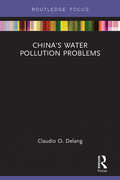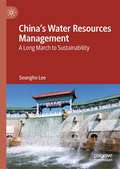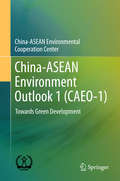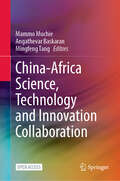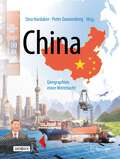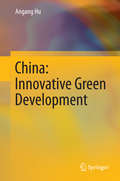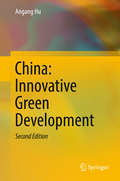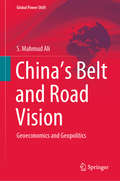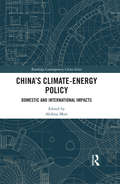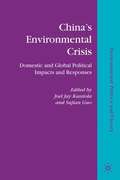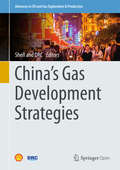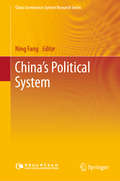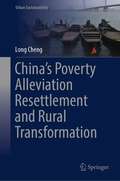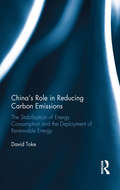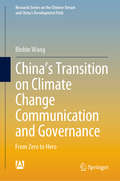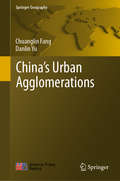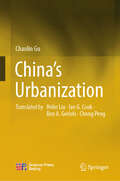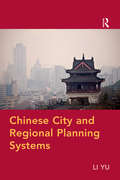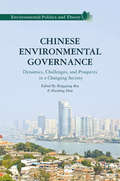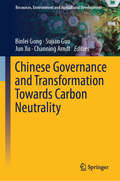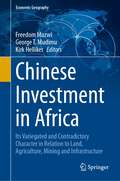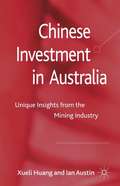- Table View
- List View
China's Water Pollution Problems
by Claudio O. DelangWater pollution is one of the most serious problems plaguing China today with millions of citizens drinking water unfit for consumption. These abysmal conditions have fuelled increasing social discontent, as people become more concerned by the need to address the pressing issues of water pollution, scarcity, and waste management. This book describes how and why China has ended up in such a dire situation, what the government is doing to address the problem and the difficulties encountered in attempting to reduce pollution. The analysis is based on both gray literature (newspaper articles, NGO reports, Chinese government information) and on academic studies. The gray literature gives a voice to those who suffer from the pollution, their advocates, and government officers, and allows the reader to better grasp the conditions on the ground, and the impact of the air pollution among the people in different areas in China. The academic literature adds a theoretical perspective and brings these different case studies into a broader context. This book will be of great interest to students of environmental pollution and contemporary Chinese studies looking for an introduction to the topic, as well as researchers looking for an analysis of China's environmental problems.
China's Water Resources Management: A Long March to Sustainability
by Seungho LeeThis book investigates water resources management and policy in China over the last two decades with a core focus on the role of water for socioeconomic development and sustainability. Recent policies, such as the Three Red Lines and the Water Ten Plan are evaluated for sustainable water supply, use and quality control. The book appraises solutions through demand management, water rights and pollution trading, virtual water and water footprint. Supply management is discussed taking examples from the Three Gorges Dam and the South North Water Transfer Project. The water market is investigated uncovering the active engagement of the private sector and includes discussions on how transboundary rivers demonstrate China’s engagement with its riparian countries for benefit sharing. This book will be an invaluable reference for researchers in the field as well as practitioners and students who have an interest in water and development in China.
China-ASEAN Environment Outlook 1 (CAEO-1)
by China-ASEAN Environmental CooperationThis book presents a comprehensive analysis of the status and progress of China-ASEAN green development and examines the common development issues in China and ASEAN Member States (AMSs). It also explores development trends within the framework of global and regional environmental governance and discusses the approaches towards green development in China and AMSs, offering its own definition of green development and using a “pressure-state-response” (PSR) model to build a framework for assessing green development. The book includes typical policy measures and numerous practices for green development in China and AMSs in the form of tables, figures and boxes. Based on detailed analysis, it argues that the global 2030 Agenda for Sustainable Development brings significant opportunities to China and AMSs, that the ongoing pragmatic cooperation should be further advanced, and that a connection between the Belt and Road Initiative and green ASEAN Community should be established to achieve regional sustainable development. As such it furthers readers’ understanding of environment and development and practical policy advice for promoting China-ASEAN cooperation on environment and green development. Intended for decision makers from the government, business sector, and civil societies who are working to boost green development and China-ASEAN cooperation, it is also a valuable resource for government officials, researchers and non-experts interested in creating a balanced relationship between the environment and development.
China-Africa Science, Technology and Innovation Collaboration
by Mammo Muchie Angathevar Baskaran Mingfeng TangThis open access book brings together researchers from a variety of disciplines to explore science, technology, and innovation cooperation between China and African countries by using different perspectives. The growing economic, technological, and scientific cooperation between Africa and China provides opportunities to jointly develop mechanisms to provide a skill base from discovery to creativity, invention, innovation, entrepreneurship and implementation for the benefit of both Africa and China. This book makes a significant contribution to the knowledge imagination understanding of the different dimensions of China-Africa STI cooperation and can reach out to all stakeholders with evidence-based research.
China: Geographien einer Weltmacht
by Peter Dannenberg Sina HardakerKein anderes Land wird die Welt und vermutlich auch Deutschland in den nächsten Jahrzehnten so sehr prägen wie China. Ob wir es wollen oder nicht, die wirtschaftliche, gesellschaftliche und ökologische Zukunft unseres Planeten wird zu einem großen Teil durch Entwicklungen und Entscheidungen in China beeinflusst. Und dennoch, wir wissen oft überraschend oder gar erschreckend wenig über diese fast allgegenwärtige, höchst vielschichtige und ambivalente Weltmacht China - ihre Geschichte, ihre Geographie(n), ihre kulturellen Hintergründe sowie gesellschaftlichen Strukturen, und schließlich das, was ihre Menschen antreibt. Der Umgang mit der Volksrepublik gestaltet sich aus westlicher Sicht nicht nur komplex, sondern auch schwierig, wird ebenso zunehmend bedeutsamer und unvermeidbar.Dieses Buch bietet die Möglichkeit die Geographie, Politik, Gesellschaft und Kultur sowie seine unterschiedlichen Regionen und Facetten besser zu verstehen. Anhand zahlreicher Karten, Fotos, Abbildungen und Beispiele spannend illustriert, stellt dieses Buch Hintergründe und Besonderheiten, aktuelle Trends und Geschichten in 46 Beiträgen vor. Knapp 50 renommierte Expert*innen schärfen den Blick auf das Land aus unterschiedlichen Perspektiven und stellen auch kontroverse Themen wie die chinesische Geopolitik, die Situation Hongkongs und Taiwans oder Chinas Rolle beim Klimawandel verständlich dar.Die Kombination aus wissenschaftlichem Fachwissen und anschaulicher Vermittlung und Illustration macht dieses Buch gleichsam für das Studium wie auch für eine breite Leserschaft interessant. Es ist eine Einladung an alle, die das Interesse und den Anspruch verfolgen, die aufgestiegene Weltmacht China wissenschaftlich fundiert besser kennenzulernen und zu verstehen.
China: Innovative Green Development
by Angang HuThis book is particularly concerned with China's path to green development and how it can be understood, exploring questions such as how the goal of Chinese-led green development can be achieved. The book provides systematic explanations of the theory of green development, exploring its background, its theoretical basis, the areas it covers, the stages it encompasses and the constraining and favorable factors involved. We see how humankind is at a period of transition from the traditional black industrial civilization to a modern green ecological civilization. The author gives a profound critique of the traditional Western model of development, provides a comprehensive analysis of the crisis and the opportunities presented by green development and depicts the grand goal of green modernization in a creative, bold, forward-looking manner. A three-step strategy to design and promote green development is proposed. Readers will discover why China must become an innovator, practitioner, and leader of green development, and how green planning is an important means to establish green development. The book explores how local governments can become green innovation practitioners, and how enterprises can become the main arena of green development. This book is a creative and innovative work that will appeal to scholars interested in the long-term development of humankind in general and China in particular. It also serves well as a green development textbook, presenting related scientific knowledge and important information for decision-making in a concise, easy-to-understand form.
China: Innovative Green Development
by Angang HuThis book is particularly concerned with China s path to green development and how it can be understood, exploring questions such as how the goal of Chinese-led green development can be achieved. The book provides systematic explanations of the theory of green development, exploring its background, its theoretical basis, the areas it covers, the stages it encompasses and the constraining and favorable factors involved. We see how humankind is at a period of transition from the traditional black industrial civilization to a modern green ecological civilization. The author gives a profound critique of the traditional Western model of development, provides a comprehensive analysis of the crisis and the opportunities presented by green development and depicts the grand goal of green modernization in a creative, bold, forward-looking manner. A three-step strategy to design and promote green development is proposed. Readers will discover why China must become an innovator, practitioner, and leader of green development, and how green planning is an important means to establish green development. The book explores how local governments can become green innovation practitioners, and how enterprises can become the main arena of green development. This book is a creative and innovative work that will appeal to scholars interested in the long-term development of humankind in general and China in particular. It also serves well as a green development textbook, presenting related scientific knowledge and important information for decision-making in a concise, easy-to-understand form. "
China’s Belt and Road Initiatives: Economic Geography Reformation
by Wei LiuThis book presents the series of lectures on the "Belt and Road Initiatives" from the Guang Ming Forum organized by Guang Ming Daily. Co-authored by Ge Jianxiong, Hu Angang, Lin Yifu, Qiao Liang and nine other respected scholars and experts, it provides a comprehensive analysis of the "Belt and Road Initiatives" and its significance in terms of economics and economic geography, yielding an insightful interpretation of the strategy. It also offers multiple perspectives, including national political, historical, military, diplomatic, cultural, technological and legal.
China’s Belt and Road Vision: Geoeconomics and Geopolitics (Global Power Shift)
by S. Mahmud AliThis book examines the evolution and major elements of China’s Belt-and-Road Initiative (BRI), a trillion-dollar project for the revival and refinement of ancient terrestrial and maritime trade routes. The author analyses the foreign policy and economic strategy behind the initiative as well as the geoeconomic and geopolitical impact on the region. Furthermore, he assesses whether the BRI has to be considered as a challenge to the US-led order, leading to a Sinocentric order in the 21st century. Offering two case studies on the China-Pakistan Economic Corridor (CPEC) and the 21st Century Maritime Silk Road (MSR), the book reveals the drivers motivating China and its partners in executing BRI projects, such as security of commodity-shipments, energy supplies, and explores trade volumes as well as the anxiety these trigger among critics. The book juxtaposes these to non-Chinese, specifically multilateral institutional and Western corporate, inputs into Beijing’s developmental planning-processes. It also identifies the role of combined Chinese-foreign stimuli in generating the policy priorities precipitating the BRI vision, and the geoeconomic essence of BRI’s implementation.
China’s Climate-Energy Policy: Domestic and International Impacts (Routledge Contemporary China Series)
by Akihisa MoriChina’s recent climate-energy policy, an outcome of contemporary challenges, has generated conflict of interest amongst major stakeholders. Coupled with a boost in demand for oil, gas and coal, as well as a rapid growth in wind and solar power, it has not only affected domestic fossil fuel and renewable energy providers, but has also provoked a resource boom, affecting development pathways internationally. This book therefore seeks to examine the economic, social and ecological effects associated with China’s climate-energy policy. Assessing how the policy has been and will be formulated and implemented, it analyses the changing use of energy, CO2 emissions and GDP, as well as social and environmental impacts both domestically and internationally. It presents in-depth case studies on specific policies in China and on its resource exporting countries, such as Indonesia, Australia, Myanmar and Mongolia. At the same time, using quantitative data, it provides detailed input-output and applied computable general equilibrium analyses. Arguing that China has actively advanced its climate-energy policy to become a leader of global climate governance, it demonstrates that China ultimately relocates the cost of its climate-energy policy to resource exporting countries. This book will be of great interest to students and scholars of energy, the environment and sustainability, as well as Chinese Studies and economics.
China’s Environmental Crisis
by Sujian Guo Joel Jay KassiolaThis path-breaking collection covers the significance of China's extreme environmental challenges for both Chinese society and the world, how these challenges are impacting domestic Chinese society and its political institutions, and how these institutions are responding in their efforts to address the environmental problems.
China’s Gas Development Strategies (Advances in Oil and Gas Exploration & Production)
by Shell International Ltd The Development Research CenterThis book is open access under a CC BY 4.0 license. This book examines how China can increase the share of natural gas in its energy system. China’s energy strategy has global ramifications and impact, and central to this strategy is the country’s transition from coal to gas. The book presents the culmination of a two-year collaboration between the Development Research Center of the State Council (DRC) and Shell. With the Chinese government’s strategic aim to increase the share of gas in the energy mix from 5.8% in 2014 to 10% and 15% in 2020 and 2030 respectively, the book outlines how China can achieve its gas targets. Providing both quantifiable metrics and policy measures for the transition, it is a much needed addition to the literature on Chinese energy policy. The research and the resulting recommendations of this study have fed directly into the Chinese government’s 13th Five-Year Plan, and provide unique insights into the Chinese government and policy-making.Due to its global impact, the book is a valuable resource for policy makers in both China and the rest of the world.
China’s Political System (China Governance System Research Series)
by Ning FangThis book includes collective research by the Institute of Political Science of the Chinese Academy of Social Sciences, which is an important research institution of political science and a think-tank in China. The book was completed by the expert team of "China's Political System" headed by Director Fang Ning for several years and after several changes in their manuscripts.This book covers the core political systems of China, such as the leadership system of the Communist Party of China, the decision-making system of the Party and government in Chinese politics, the system of the people's congress, the relationship between the central and local authorities, the system of officials training and selection, the system of discipline inspection and supervision, the system of consultative democracy and the system of community-level self-governance, etc.This book aims to build a new paradigm of empirical research and introduction of the contemporary Chinese political system by using the description and research method of materialization and dynamics of the political system.
China’s Poverty Alleviation Resettlement and Rural Transformation (Urban Sustainability)
by Long ChengThis book aims to offer a comprehensive understanding of China’s Poverty Alleviation resettlement (PAR) particularly under the Link Policy, and further analysing the impacts of PAR on China’s rural transformation from multiple scales (regional and individual) and perspectives (social-economic development, urban-rural interactions and landscape changes), with a combination of multiple approaches including systematic literature review, content analysis, econometrical methods, spatial analysis, Cellular Automata modelling etc. Policy suggestions will also be provided to improve farmers’ sustainable livelihood and resilience coping with the changes of lifestyles due to the resettlement. This book contributes to inspiring and provoking thought among policymakers, researchers, and individuals worldwide grappling with the pressing issue of poverty and its eradication. Understanding the Chinese experience may yield valuable insights that can be adapted and applied in diverse contexts around the globe.
China’s Resources, Energy and Sustainable Development: 2020
by Tsinghua-Rio Tinto Joint Research Centre for Resources, Energy and Sustainable Development Institute of Climate Change and Sustainable Development, Tsinghua UniversityThis book explores sustainable development from the perspective of resources and energy, based on China’s practical experience and cross-disciplinary research. It focuses on major challenges, key solutions and policy recommendations, and studies and explores seven important themes of resources, energy and sustainable development, including: 1) China’s low-carbon energy transition, 2) China’s urbanization and low-carbon development, 3) China’s low-carbon action in cities, 4) China’s low-carbon power transition, 5) China’s water resources management, 6) electric vehicle development and key metal resources and 7) China’s low-carbon development of the iron & steel industry. This book contributes to a more integrated understanding of many themes and their relationships in the area of resources, energy and sustainable development and guides the related policy and management.
China’s Role in Reducing Carbon Emissions: The Stabilisation of Energy Consumption and the Deployment of Renewable Energy
by David TokeChina, a still developing economy comprising a fifth of the world’s population, will play a key role in the global movement towards reducing carbon emissions. The aims of the Paris Agreement may stand or fall with China, both for its own contribution and the example it will set the developing world. China’s Role in Reducing Carbon Emissions discusses the prospects for China achieving radical reductions in carbon emissions, within the context of the current economic and political landscape. With a particular focus on technologies such as such as wind power, solar power and electric vehicles, Toke examines how China is transitioning to a state of stable energy consumption via a service-based economy and heavy investment in non-fossil energy sources. The book concludes that China may be set to reduce its carbon emissions by approximately two-thirds by 2050. This book is a valuable resource for students and scholars of climate change, sustainable development, political science and energy, as well as energy professionals seeking to understand the implications of recent developments in China.
China’s Strategy in Space (SpringerBriefs in Space Development)
by Stacey SolomoneThis book addresses why China is going into space and provides up- to-date information on all aspects of the Chinese Space Program in terms of launch vehicles, launch sites and infrastructure, crew vehicles for space exploration, satellite applications and scientific exploration capabilities. Beyond mere capabilities, it is important to understand how Chinese aerospace leaders think, how they make decisions, and what their ultimate goal is during their space endeavors. What are Chinese intentions in space? To what extent does culture and ethics influence Chinese strategic decision-making within the highest levels of the aerospace industrial complex? This book examines these questions and offers four potential scenarios on where the Chinese space program is headed based on this new perspective of understanding China's space goals. This book is not only required reading for policy makers and military leaders in the US government, but also for the general population, students, and professionals interested in truly understanding the reasons behind what the Chinese are doing in space.
China’s Transition on Climate Change Communication and Governance: From Zero to Hero (Research Series on the Chinese Dream and China’s Development Path)
by Binbin WangThis book provides a two-level analytical framework and empirical study to analyze the reason and process of China’s transition that is from a follower to driver in the field of global climate governance, and is especially valuable the dialogues and cooperation between the government, media and civil society. Nowadays, China shows strong leadership to push the process of global climate governance. It’s the first and fastest time in the past 40-year history of China’s Opening-up that China wins the international respect and trust in one of the issues of global governance. What experiences can be summarized? What dynamic situations and new possibilities emerged after Trump, the U.S. president announced to withdraw from the Paris Agreement? How to move forward based on the existing success? This timely book offers new lens for international readers to understand China’s effort domestically and internationally in the field of climate change and illustrate the outlook of the climate governance in the frame of win-win co-governance model.
China’s Urban Agglomerations (Springer Geography)
by Chuanglin Fang Danlin YuThe book combs through extensively 32,231 urban agglomeration related works during the past 120 years to explore a theoretically supported and practically based definition of urban agglomeration. Based on the definition, the authors explore intensively the fundamental characteristics, spatiotemporal differentiation properties, and existing issues for China’s sustainable urban agglomeration development for the past 35 years. The study proposes that China shall focus on the construction and sustainable development of five primary national-level urban agglomerations. In the meantime, China shall also steadily and gradually construct 9 regional urban agglomerations and guide the development and growth of 6 local urban agglomerations. In the long run, China will have a hierarchical “5+9+6” closely integrated hierarchical urban agglomeration spatial structure. The study also proposes to coordinate the construction and development of urban agglomerations on the “two belts and one road” to form a national new urbanization development strategic pattern that enables “the axis to connect the agglomerations while the agglomerations support the axis.” Furthermore, the study investigates a variety of strategic thinking and suggestions for creating innovative, green and ecologically friendly, intelligent, low-carbon, open, culture-oriented, market-oriented and shared urban agglomerations in China. This book will be a comprehensive reference both for scholars and decision-makers engaged in urban development and planning and environmental protection departments. It can also serve as textbook for graduate students of relevant fields.
China’s Urbanization
by Chaolin GuThis book tries to root its exploration of China’s urbanization in the very local realities of China from the perspective of urban geography and international urbanization theory. The research is of large scale, full process and boasts the feature of multidimensional and systematic thinking. In order clearly illustrate the full dimensions of China’s urbanization, each chapter presents series of well-designed figures and tables to enhance the book’s readability and clarity. This book can be used as a reference for scholars and decision makers who are engaged or interested in China's urbanization policy, urban and regional planning, and socioeconomic transformation.
Chinese City and Regional Planning Systems
by Li YuWhile the Chinese planning system is vitally important to the rapid development which has been taking place over the past three decades, this is the first text to provide a comprehensive examination and critical evaluation of this system. It sets the current system in historical context and explains the hierarchy of government departments responsible for planning and construction, the different types of plans produced and recent urban planning innovations which have been put into practice. Illustrated with boxed empirical case studies, it shows the problems faced by the planning system in facing the uncertainty in the market economy. In all, it provides readers with a full understanding of a complex and powerful system which is very distinct from other planning systems around the world. As such, it is essential reading for all students interested in the current development taking place in China and, in addition, to planning students with a general interest in planning systems and theory.
Chinese Environmental Governance: Dynamics, Challenges, and Prospects in a Changing Society (Environmental Politics and Theory)
by Bingqiang Ren Huisheng ShouThis book offers the most updated research on the dynamics, challenges, and prospects in China's environmental governance.
Chinese Governance and Transformation Towards Carbon Neutrality (Resources, Environment and Agricultural Development)
by Jun Xu Sujian Guo Channing Arndt Binlei GongThis book provides the first comprehensive and systematic account of the multi-level governance system adopted by China in realizing the Dual-Carbon transition. This governance system encompasses the participation of the government, the market, industry and all sectors of society, and emphasizes coordination and cooperation between all levels of government between different sectors, and between domestic and international levels. The book finds that the government can play an important leadership and guidance role in the Dual-Carbon transition. By formulating and implementing relevant policies, regulations and planning, the government can promote the process of Dual-Carbon development. Second, the full utilization of market mechanisms also plays a key role. Through measures such as establishing a carbon market and promoting carbon pricing, the market mechanism promotes the innovation and application of low carbon technologies. In addition, the active participation of industry is an indispensable factor in realizing a Dual-Carbon transition. Industry and agriculture have contributed to Dual-Carbon development by promoting the efficient use of resources and the adoption of green production methods. Finally, raising public awareness and participation in environmental protection is also indispensable, and the process of Dual-Carbon transition is effectively promoted through publicity and education, social organizations and public participation. By addressing multiple themes, this book provides a comprehensive understanding and in-depth analysis of the Dual-Carbon transition, and offers scientific guidance and policy recommendations for China's sustainable development and the achievement of Dual-Carbon goals. At the same time, the significance of this book lies in the fact that it provides reference for other countries and regions, and makes a positive contribution to global climate governance. Parts of this book's translation from its Chinese original manuscript were completed with the assistance of artificial intelligence. The author subsequently revised the content.
Chinese Investment in Africa: Its Variegated and Contradictory Character in Relation to Land, Agriculture, Mining and Infrastructure (Economic Geography)
by Kirk Helliker Freedom Mazwi George T. MudimuThis edited volume systematically interrogates the Chinese investment presence in Africa, focusing on land and agriculture, mining and other infrastructural projects. In doing so, the form and extent of Chinese debt will be brought into perspective, with comparisons made to investments in Africa emanating from metropolitan capitalism. The volume examines the development potential of these investments by focusing on the labour regimes created and the effects of investments on the land-based agricultural livelihoods of the African peasantry. This entails the use of a political economy approach which incorporates the state, international actors and local communities into the analysis, with gender dynamics also of great significance. Overall, the contributions in this volume focus on an array of African nations (with a specific focus on Zimbabwe) and they deploy a large wealth of primary field-based data collected over a number of years by established and emerging scholars living andworking on the continent.
Chinese Investment in Australia
by Xueli Huang Ian AustinAustralia is renowned for its abundance of natural resources and is one of the largest recipients of Chinese direct investment. State- and privately-owned Chinese firms have invested heavily in the Australian minerals industry to secure a supply for their domestic production. In this book, the authors provide a comprehensive review of how Chinese firms have successfully invested in the Australian mineral industry based on their extensive research and consulting experiences. They provide unique insights into the entry processes used by Chinese investors, factors contributing to their successes, lessons they have learnt, and the challenges they have encountered in managing their investment. Moreover, the book also elaborates on how the political, economic and competitive forces in both countries influence Chinese investments in Australia. It is an informative tool for domestic and international policy makers, business professionals, academic and informed readers with interests on how China's resource requirements are impacting the Australian political and commercial landscape.
